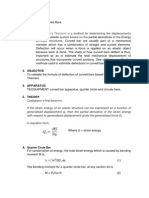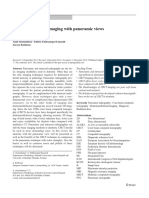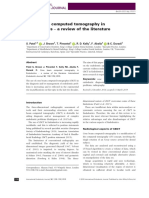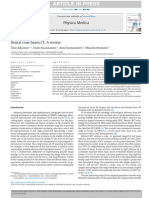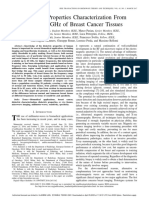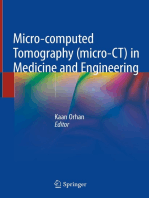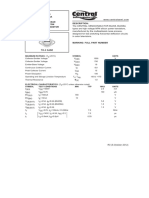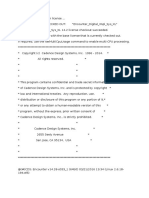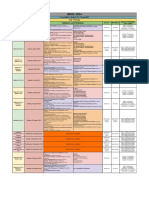What The General Dental Practitioner Should Know About Cone Beam Com-Puted Tomograph Technology
What The General Dental Practitioner Should Know About Cone Beam Com-Puted Tomograph Technology
Uploaded by
danmoviCopyright:
Available Formats
What The General Dental Practitioner Should Know About Cone Beam Com-Puted Tomograph Technology
What The General Dental Practitioner Should Know About Cone Beam Com-Puted Tomograph Technology
Uploaded by
danmoviOriginal Title
Copyright
Available Formats
Share this document
Did you find this document useful?
Is this content inappropriate?
Copyright:
Available Formats
What The General Dental Practitioner Should Know About Cone Beam Com-Puted Tomograph Technology
What The General Dental Practitioner Should Know About Cone Beam Com-Puted Tomograph Technology
Uploaded by
danmoviCopyright:
Available Formats
What the general dental practitioner should know about cone beam computed tomograph technology
Magdalena Marinescu Gava1
1 D.D.S. Pirkanmaa Hospital District, Regional Imaging Centre, Tampere, Finland.
Abstract Ionising radiation is used in health care for the diagnosis of diseases, for prevention (such as screening for breast cancer) and for treatment (radiotherapy). The aim of radiation protection is to ensure that radiation is used safely and that exposure of the patient is kept to a minimum. The principles of radiation protection are based on the recommendations of the International Commission on Radiological Protection (ICRP). To be acceptable, the use of ionising radiation must be justified, optimal, and limited. Dental radiography has been used since the beginning of radiology and now accounts for nearly one-third of the total number of radiological examinations in the European Union. Pantomography is widely used because in one exposure it records the jaws, temporomandibular joints, maxillary sinuses, and dentition. However, when this technique is used, superimposition of structures in the dentomaxillofacial area has been a limitation in making reliable diagnoses due to the complexity of the anatomy in this region. These shortcomings have led to development of three-dimensional techniques. One of these techniques, cone-beam computed tomography (CBCT), is now available for use in everyday general practice. The aim of this paper is to present CBCTs advantages and limitations when compared with alternative imaging techniques and to stress how it may be used safely in general dental practice. Key Words: Medical Subjects, Radiation Protection, Dentistry, Cone-Beam Computed Tomography (CBCT)
Introduction
Although the doses of ionising radiation generated during dental examinations are in general relatively low, dental radiology accounts for nearly one-third of the total number of radiological examinations in the European Union and therefore deserves specific attention with regard to radiation protection [1]. In radiology, protection of patients requires that any investigation using ionising radiation is justified, optimised, and minimised for each patient. When seeking a diagnosis using ionising radiation, it is critical to keep the balance between the potential gain in information and the risk to the patient from exposure to ionising radiation. The rule known as ALARA (as low as reasonably achievable) summarises this concept and implies the achievement of good diagnostic images with a minimum of exposure to radiation [2]. Imaging of the maxillofacial area is developing fast, evolving from the two-dimensional radiography (intra-oral film or pantomography), with its shortcomings due to superimposing of structures, to three-dimensional techniques that take into account
the complicated human anatomy. Such threedimensional techniques include magnetic resonance imaging (MRI), computed tomography (CT), and the newer CBCT, which includes cone-beam tomography, volumetric computed tomography, micro CT, and digital volume tomography (DVT) [3-5]. In head and neck examinations, MRI is a threedimensional traditional/alternative technique, which does not use ionising radiation and is ideal for investigating soft tissues. However, it is not readily available, requires lots of space and expensive equipment, and is rather poor at evaluating hard tissues. Technology using ionising radiation is cheaper, is more widely available, has good performance in hard-tissue imaging, but comes with biological risks: some effects of radiation are deterministic (depending on the quantity of radiation used) and some are stochastic (having no threshold, leading to changes in cellular structures, causing cancer and genetic modification in chromosomes, thus genetic modification in genome of offspring, etc.) [2].
Corresponding author: Magdalena Marinescu Gava, Pirkanmaa Hospital District, Regional Imaging Centre, Finnish Student Health Service, Tampere, Finland; e-mail: magdalena_gava@hotmail.com 14
OHDMBSC - Vol. VIII - No. 4 - December, 2009
Although the quantity of radiation absorbed in traditional intra-oral radiography in the dentomaxillofacial area is relatively small, the use of CT can result in far greater exposure to ionising radiation. In addition, classic CT is expensive and the equipment required takes up a lot of space. CBCT provides a complement to or a substitute for traditional CT, especially in dentistry [6-8]. Initially designed as experimental equipment, micro-CT involved long exposure and high radiation doses. With time, very compact scanners have been developed and nowadays CBCT equipment is more compact, much cheaper, and generates less ionising radiation than classic CT. The radiation beam is not fan-like as it is in CT; it is cone-shaped and the area of investigation can be limited to the area of interest. In dentistry, the use of CBCT is becoming part of everyday general practice. In order to protect patients best against radiation, is important to know the correct indications for the use of this type of investigation and the right techniques. This will ensure that sufficient information for a reliable diagnosis is produced using the lowest possible dosage of ionising radiation.
CBCT Techniques
The ionising radiation emitted during CBCT is not in a linear or fan-like beam, but is a cone-shaped beam. The name of tomography comes from tomos (slices, in Greek) and graph (to draw). During exposure to produce a CBCT image, the information is sent to a computer throughout a 180360 degree rotation on a two-dimensional sensor (digital detector). The field of view (FOV) varies with the scanner from one device to another. FOV has a cylindrical shape, is a few centimetres high and has a diameter of 3-20 cm. The FOV can be chosen with respect to the investigative needs. The time needed to obtain the images is divided into scanning time and recording time, and the computer reconstructs three-dimensional structures using complex algorithms. There is excellent fidelity of the image in all dimensions and the resolution is very high. The thickness of slices varies between 0.125 and 2 mm, depending on device and operators choice. The operator can choose the axial, coronal or sagittal view and acquire information from the appropriate direction. For example, in devices with a big FOV, images for cephalometric analysis are recorded from lateral and postero-anterior directions. The information is stored in voxels. A voxel (a combination of volume and pixel) is a unit for measuring the volume of stored information. One voxel is a cube with 0.08-4 mm edges [7-9]. The exposure time depends on the machines FOV and the desired resolution of the image.
Aim
Against this background, the aim of this paper is to present the indications for the use of CBCT and its advantages and limitations when compared with alternative imaging techniques, in the overall context of protecting patients from excessive use of ionising radiation.
General Principles
Due to the considerably higher radiation dose required, CBCT is not recommended as a routine investigation and there should always be a strong indication for its use. All those working with ionising radiation should receive adequate theoretical and practical training for radiation safety issues. Continuing education and training following qualification are required, particularly when new equipment or techniques are adopted. Mastering the technique and a justifiable indication for its use protects the patient from excessive or unjustified ionising radiation. The efficacy, benefits and risks of available alternative techniques, having the same objective but involving no or less exposure to ionising radiation, should also be taken into account by practitioners, who can make informed, responsible, and thus sensible choices when investigating their patients.
15
Makes and Types of CBCT Machine (Devices)
CBCT machines (devices) may vary in relation to: The size of structure to be imaged. Geometrical resolution. Contrast. Slice thickness. Ionising radiation dose. When this paper was written, there were more than 20 different devices available, some of which can be attached to pantomographic machines. They included: 3DX Accuitomo (Morita), NewTom9000 and NewTom 3G (AFP Imaging), Siremobil ISOC-3D (Siemens Medical Solutions), I-CAT (ISI) and CB MercuRay (Hitachi), Scanora 3D (Soredex), Promax 3D (Planmeca), Kodak 9500 (Kodak), Picasso Master (E-WOO), Galileos (Sirona) (Figure 1).
OHDMBSC - Vol. VIII - No. 4 - December, 2009
Indications
As CBCT develops, it is possible that a number of further indications will come to light. Grndahl (2007) [11] reported that in Sweden in 2007 the relative frequency in the use of CBCT between different oral specialties was: Implantology: 40% Oral surgery: 19% Orthodontics: 19% Endodontics: 17% Temporomandibular joint (TMJ): 1% Oto-rhino-laryngology: (ENT) 2% Other investigations 2% (periodontology, forensic dentistry, research). These figures may or may not be replicated by findings from other studies but do give some indication of the possible current use of CBCT for oral purposes by specialty. Specific uses for CBCT by specialty have been reported and are listed below. Implantology [12, 13] To assess the quantity and quality of bone in edentulous ridges. To assess the relation of planned implants to neighbouring structures. To assess the success of implant-osseointegration. To provide information on correct placement of implants (Figure 2). Before ridge augmentation in anodontia. Before bone reconstruction and sinus lifting. During planning and in designing a surgical guidance template. Dentoalveolar and maxillofacial surgery [9,12-14] To assess: The presence or absence of tumours. Lower molars and relationship with mandible canal. Impacted teeth, residual roots (Figure 3).
Figure 1. Cone-beam computed technology (CBCT) machine. In the majority of devices, the patient either stands up or sits in a chair while the tube and the detector rotate around him/her. Some companies offer modified versions, with a bigger FOV (13-20 cm), or those that can be used while the patient is lying down. This option is very useful when obtaining images for patients with traumatic injuries. There are modified versions with a big FOV that are especially useful for cephalostatic imaging. There are also devices for intra-operator use and some have a C-arm (e.g., Siremobil ISO-C-3D; Siemens Medical Solutions).
Effective Doses
The doses of ionising radiation generated during imaging [7] are set out in Table 1. It is advantageous for devices to be adjustable for features such as FOV, voltage, amperage, exposure time and image resolution so that the operator is able to customise the settings for each individual patient, to obtain good quality diagnostic image consistent with the need to minimise the radiation dose (ALARA) [10].
Table 1. Typical Doses of Ionising Radiation Generated During Exposure for Panoramic and CBCT Images Examination Panoramic Small FOV CBCT Large FOV CBCT CT scan (dental programme) Effective patient dose (Sv) 24 48-652 68-1073 5347-2100
16
Dose as the multiple of the dose from a typical panoramic exam 1 2-27 3-45 22-88
OHDMBSC - Vol. VIII - No. 4 - December, 2009
- Dislocation. - Luxation. Orbital fractures: MRI is more sensitive but CBCT can assess high-contrast structures such as lateral and median walls or search for foreign bodies. Condylar fractures. Mid-face fractures: larger-volume CBCT scanners acquire the entire maxillofacial region within a FOV up to 20 cm in diameter.
Figure 2. Use of CBCT in sinus lifting and planning. Superior teeth and position of the roots in respect to the maxillary sinus. Peri-oral abscesses, facial pain, trismus, differential diagnostic (presence or absence, source, and precise localisation in maxillofacial area). Foreign bodies. Cystic lesions and their delimitation (Figure 4). Osteomyelitis. In trauma cases, CBCT is able to show a larger number of fracture lines and fractures when compared with conventional images, depicting precisely the position and orientation of displaced fragments in a reasonably short time interval. Such cases include: Dentoalveolar fractures (Figures 8 and 9): - Tooth fractures (a fracture line is easier to visualise in an intact tooth rather than in a tooth that has been restored, due to artefacts). - Avulsion.
17
Figure 3. Retained teeth, their relationship with neighbouring structures and resorption of other teeth. Orthodontics [14-17] In cases of anodontia. When planning orthognathic surgery. In obstructive sleep apnoea, evaluation of air space. Clefts of the palate: - Uni- or bilateral. - Positions of teeth (Figure 5). - Planning operations and orthodontic treatment, localisation of eventual bone. - Control of intervention. - Supernumerary teeth in palate cleft: position, angulations. Cephalometric analysis (special programs).
OHDMBSC - Vol. VIII - No. 4 - December, 2009
Figure 4. Follicular cyst and impacted lower wisdom tooth, extension, relationship to the mandible nerve canal. Endodontics [18-20] To assess: Upper molars where, because three or more root canals are present, they are frequently superimposed on two-dimensional images when using conventional radiographic techniques. Cysts, granulomas, periapical lesions. Endodontic surgery, evaluation of fractured instruments in canal. Unobturated, lateral or supernumerary root canals. Maxillary sinus involvement after apical infection. CBCT, using limited quantities of ionising radiation, may be an alternative to intra-oral imaging of multi-rooted teeth when the latter does not allow each tooth to be viewed separately. For single-rooted teeth, conventional intra-oral imaging remains the technique of choice when evaluating the quality of root fillings. Temporomandibular joint [21] Investigating bony structures of TMJ; the disc is best visualised by MRI. Osteoarthritis (bone destruction) and ankylosis.
18
Figure 5. Orthodontics.
Figure 6. Periapical lesions after root canal treatment. Condylar fractures (localisation of fracture lines and dislocated fragments). Articular osteofytes.
OHDMBSC - Vol. VIII - No. 4 - December, 2009
The relationship of the condylar head to the glenoid fossa. Bone erosions, malformations, condylar modifications (Figure 7). Periodontology [22] Very accurate analysis of bone loss as well as bone healing after periodontal treatment or regenerative therapy. CBCT is a very sensitive method for imaging mineralised tissues (Figure 10). Periodontal complications arising from root fractures, which can be visualised with CBCT when a two-dimensional image fails to give any information.
Figure 9. Follow-up of trauma treatment on pantomography and CBCT. Other investigations [11, 13] Imaging of the ear. Experimental use. Osteoporosis and bone healing after antiosteoporotic medication.
Figure 7. Condylar morphology.
Figure 10. True periodontal involvement. Figure 8. Dentoalveolar trauma on traditional film and CBCT.
19
OHDMBSC - Vol. VIII - No. 4 - December, 2009
Advantages of CBCT
CBCT offers high quality in-office imaging, as the technique is easy to apply and has easy-to-use postprocessing and viewing software. Compared with classic radiographs, measurements obtained by the use of CBCT are very exact, because the resulting images are actual size and high-resolution 3D. The resulting data have the potential for generating all 2D images in a single scan (e.g., dental panoramic tomogram, lateral cephalogram). It is the most accurate method for assessing the bony structures of the TMJ. Another major advantage of CBCT in head and neck region is the possibility of reducing the size of the area under investigation to the relevant field, for example a small unilateral area. Compared to traditional CT, CBCT is cheaper, smaller, emits less ionising radiation, has a shorter exposure time and gives better image resolution.
Limitations and Disadvantages of CBCT
It is definitely more expensive than classic two-dimensional radiologic investigations. The dose of ionising radiation generated is greater than in a pantomography investigation. As a new technology, it requires new competences from the clinician and the value of information obtained is interpretation-sensitive. Any movement artefacts affect the whole data set and the whole image rather than just one part. It provides limited resolution of deeper (inner) soft tissues, and MRI and classic CT are better for soft-tissue imaging. It has low contrast range (dependent on the type of x-ray detector). It has increased noise from scattered radiation and concomitant loss of contrast resolution. It cannot be used for estimation of Hounsfield Units (HU) [9].
CBCT offers high quality in-office imaging that can greatly improve patient care; on the down side, the radiation dose that the patients are exposed to is much greater than for traditional radiography. The easy accessibility and handling of CBCT scanners could encourage the use of this technique in general practice. However, there is a risk that some practitioners may lack sufficient anatomical knowledge and experience to interpret the resulting images, which may have medicolegal consequences. There should always be a very clear and strong indication for any tomographic investigation. The use of CBCT as routine substitute of pantomography is not recommended. It is essential that any radiographic examination should give a net benefit to the patient, weighing the total potential diagnostic benefits that it produces against the individual detriment that the exposure to ionising radiation might cause. The efficacy, benefits and risks of available alternative techniques having the same objective but involving no or less exposure to xrays should always be taken into account. Mastery of the technique protects patients from excessive or unjustified ionising radiation. Individual protection is most important in any method using ionising radiation (right indication, lead shielding, collimation, a quality control programme, special attention for children and pregnant women, etc.). Users have to be aware of their responsibility to interpret the data thoroughly or to collaborate and work with trained professionals, such as specialised radiographers, who can help them to do so. A core curriculum for training in the use of CBCT has yet to be developed. Recently, a set of 20 basic principles on the use of dental CBCT has been accepted by the European Academy of Dentomaxillofacial Radiology and, it is hoped, will be of value in national standard setting within Europe for dentists, dental specialists, and equipment manufacturers [23].
Acknowledgement
The author thanks Dr. Anni Suomalainen from the Department of Radiology, Helsinki University Central Hospital, for providing valuable help and iconography and Dr. Annukka Vuorinen, Chief Dentist at Finnish Student Health Service, Tampere, for her assistance and support.
Conclusions
Any x-ray exposure entails a risk to the patient. Under normal circumstances, the risk from dental radiography is very low, but can be high in neighbouring tissues: thyroid, salivary glands and brain.
References
1. The 2007 Recommendations of the International Commission on Radiological Protection. ICRP publication 103. Annals of the ICRP 2007; 38: 1-242. 2. European Commission. Radiation Protection 136. European Guidelines on Radiation Protection in Dental Radiology. The Safe Use of Radiographs in Dental Practice.
20
OHDMBSC - Vol. VIII - No. 4 - December, 2009
Luxembourg: Office for Official Publications of the European Communities; 2004. Accessed (2009 Sept 18) at: http://ec. europa.eu/energy/nuclear/radioprotection/publication/doc/136 _en.pdf 3. Roberts JA, Drage NA, Davies J, Thomas DW. Effective dose from cone beam CT examinations in dentistry. British Journal of Radiology 2009; 82: 35-40. 4. Suomalainen A, Kiljunen T, Kser Y, Peltola J, Kortesniemi M. Dosimetry and image quality of four dental cone beam computed tomography scanners compared with multislice computed tomography scanners. Dentomaxillofacial Radiology 2009; 38: 367-378. 5. Suomalainen AK, Salo A, Robinson S, Peltola JS. The 3DX multi image micro-CT device in clinical dental practice. Dentomaxillofacial Radiology 2007; 36: 80-85. 6. Cohnen M, Kemper J, Mbes O, Pawelzik J, Mdder U. Radiation dose in dental radiology. European Radiology 2002; 12: 634-637. 7. Ludlow JB, Davies-Ludlow LE, Brooks SL. Dosimetry of two extraoral direct digital imaging devices: NewTom conebeam CT and Orthophos Plus DS panoramic unit. Dentomaxillofacial Radiology 2003; 32: 229-234. 8. Ludlow JB, Davies-Ludlow LE, Brooks SL, Howerton WB. Dosimetry of 3 CBCT devices for oral and maxillofacial radiology: CB Mercury, NewTom 3G and i-CAT. Dentomaxillofacial Radiology 2006; 35: 219-226. 9. Shintaku WH, Venturin JS, Azevedo B, Noujeim M. Applications of cone-beam computed tomography in fractures of the maxillofacial complex. Dental Traumatology 2009; 25: 358-366. 10. Holroyd JR, Gulson AD. The Radiation Protection Implications of the Use of Cone Beam Computed Tomography (CBCT) in Dentistry: What You Need to Know. London: Health Protection Agency Radiation Protection Division; 2009: pp.1-10. 11. Grndahl H-G. Jaw imaging with cone beam CT [oral presentation]. 20th meeting of the European Society of Head and Neck Radiology; 2007 Sept 8; Oslo, Norway. 12. De Vos W, Casselman J, Swennen G. Cone-beam computerized tomography (CBCT) imaging of the oral and maxillofacial region: a systematic review of the literature; International Journal of Oral and Maxillofacial Surgery 2009; 38: 609-625. 13. Robinson S, Suomalainen A, Kortesniemi M. MicroCT. European Journal of Radiology 2005; 56: 185-191. 14. Cevidanes LH, Bailey LJ, Tucker SF, Styner MA, Mol A, Phillips CL, et al. Three-dimensional cone-beam computed tomography for assessment of mandibular changes after orthognathic surgery. American Journal of Orthodontics and Dentofacial Orthopedics 2007; 131: 44-50. 15. Holberg C, Steinhuser S, Geis P, Rudzki-Janson I. Cone-beam computed tomography in orthodontics: benefits and limitations. Journal of Orofacial Orthopedics 2005; 66: 434-444. 16. Sakabe J, Kuroki Y, Fujimaki S, Nakajima I, Honda K. Reproducibility and accuracy of measuring unerupted teeth using limited cone beam X-ray CT. Dentomaxillofacial Radiology 2007; 36: 2-6. 17. Silva MA, Wolf U, Heinicke F, Bumann A, Visser H, Hirsch E. Cone-beam computed tomography for routine orthodontic treatment planning: a radiation dose evaluation. American Journal of Orthodontics and Dentofacial Orthopedics 2008; 133: 640. 18. Patel S, Horner K. The use of cone beam computed tomography in endodontics. International Endodontic Journal 2009; 42: 755-756. 19. Sogur E, Baksi BG, Grndahl HG. Imaging of root canal fillings: a comparison of subjective image quality between limited cone-beam CT, storage phosphor and film radiography. International Endodontic Journal 2007; 40: 179-185. 20. Tsurumachi T, Honda K. A new cone beam computerized tomography system for use in endodontic surgery. International Journal of Oral and Maxillofacial Surgery 2007; 40: 224-232. 21. Tsiklaklis K, Syriopouluos K, Stamatakis HC. Radiographic examination of TMJ using cone beam computed tomography. Dentomaxillofacial Radiology 2004; 33: 196-201. 22. Park CH, Abramson ZR, Taba M Jr, Jin Q, Chang J, Kreider JM, et al. Three-dimensional micro-computed tomographic imaging of alveolar bone in experimental bone loss or repair. Journal of Periodontology 2007; 78: 273-281. 23. Horner K, Islam M, Flygare L, Tsiklakis K, Whaites E. Basic principles for use of dental cone beam computed tomography: consensus guidelines of the European Academy of Dental and Maxillofacial Radiology. Dentomaxillofacial Radiology 2009; 38:187-195.
)
21
You might also like
- Curved BarDocument11 pagesCurved BarJonathan Boyd100% (1)
- State-Of-The-Art On Cone Beam CT Imaging For Preoperative Planning of Implant PlacementDocument7 pagesState-Of-The-Art On Cone Beam CT Imaging For Preoperative Planning of Implant Placementanimeilove3No ratings yet
- RadiologyDocument10 pagesRadiologysaraNo ratings yet
- CBCT and Implant Dentistry Bornstein - Et - Al-2017-Periodontology - 2000Document22 pagesCBCT and Implant Dentistry Bornstein - Et - Al-2017-Periodontology - 2000Dr. DeeptiNo ratings yet
- BulganDocument10 pagesBulganIkh nahia Ikh Nakhia PharmNo ratings yet
- 2015 Time to move from ALARA to ALADADocument3 pages2015 Time to move from ALARA to ALADAtanddentalclinicNo ratings yet
- Editorial The Use of Cone Beam Computed Tomography in EndodonticsDocument2 pagesEditorial The Use of Cone Beam Computed Tomography in EndodonticsAkhilesh ReddyNo ratings yet
- Jurnal 3 - Imaging Anatomy of The Jaw and Dentition With Cone Beam Computed Tomography - Febby Sitti NurDocument11 pagesJurnal 3 - Imaging Anatomy of The Jaw and Dentition With Cone Beam Computed Tomography - Febby Sitti NurFEBBY SITTINo ratings yet
- Cone-Beam Computed Tomography and Its Applications in Dental and Maxillofacial RadiologyDocument11 pagesCone-Beam Computed Tomography and Its Applications in Dental and Maxillofacial RadiologyenzoNo ratings yet
- Physica Medica: Timo Kiljunen, Touko Kaasalainen, Anni Suomalainen, Mika KortesniemiDocument17 pagesPhysica Medica: Timo Kiljunen, Touko Kaasalainen, Anni Suomalainen, Mika Kortesniemiluis alejandroNo ratings yet
- 2014 - Article - 379 ComparaisonDocument16 pages2014 - Article - 379 ComparaisonMarouaBOUFLIJANo ratings yet
- PR CBCT Minimum Dose For Maximum Safety ENDocument6 pagesPR CBCT Minimum Dose For Maximum Safety ENSam Al AbabNo ratings yet
- CBCT in Orthodontics by Almuzian 1Document6 pagesCBCT in Orthodontics by Almuzian 1Anurtha AnuNo ratings yet
- Cone Beam Computed Tomography Imaging of Dentoalveolar and Mandibular FracturesDocument8 pagesCone Beam Computed Tomography Imaging of Dentoalveolar and Mandibular FracturesMeris JugadorNo ratings yet
- ConebeamstatementDocument6 pagesConebeamstatementPaweł SieradzkiNo ratings yet
- EJMCM Volume 7 Issue 11 Pages 5269-5275Document7 pagesEJMCM Volume 7 Issue 11 Pages 5269-5275Putu WidiastriNo ratings yet
- CBCTDocument14 pagesCBCTpoorva shahNo ratings yet
- ENDO Aae-Aaomr-2015updateDocument7 pagesENDO Aae-Aaomr-2015updateSara MoustafaNo ratings yet
- Patient Shielding During Dentomaxillofacial RadiographyDocument12 pagesPatient Shielding During Dentomaxillofacial RadiographyAainaa KhairuddinNo ratings yet
- CBCT - Cone Beam Computed TomographyDocument11 pagesCBCT - Cone Beam Computed TomographyandreemNo ratings yet
- Comparison of Cone-Beam Imaging With Orthopantomography and Computerized Tomography For Assessment in Presurgical Implant DentistryDocument10 pagesComparison of Cone-Beam Imaging With Orthopantomography and Computerized Tomography For Assessment in Presurgical Implant DentistryMihai DascalescuNo ratings yet
- 2019 - Patel - Use of Cone Beam ComputedDocument4 pages2019 - Patel - Use of Cone Beam ComputeddentistryrashaNo ratings yet
- Use of Cone Beam Computed Tomography in EndodonticsDocument67 pagesUse of Cone Beam Computed Tomography in EndodonticsDr.O.R.GANESAMURTHINo ratings yet
- The Role of CBCT in The Evaluation of Periodontal DiseasesDocument5 pagesThe Role of CBCT in The Evaluation of Periodontal DiseasesMeris JugadorNo ratings yet
- AJNR - Conebeam CT of The Head and Neck, Part 2 - Clinical ApplicationsDocument9 pagesAJNR - Conebeam CT of The Head and Neck, Part 2 - Clinical ApplicationslmcgarethNo ratings yet
- DMFR 20130291Document7 pagesDMFR 20130291Dragos CiongaruNo ratings yet
- 2017 - Use of MRI in Orthodontics - A ReviewDocument3 pages2017 - Use of MRI in Orthodontics - A ReviewSrdjan StojanovskiNo ratings yet
- Implications of CBCT in Pediatric Dentistry-A ReviewDocument8 pagesImplications of CBCT in Pediatric Dentistry-A ReviewIJAR JOURNALNo ratings yet
- Imaging in Periodontics PerioDocument49 pagesImaging in Periodontics PerioFourthMolar.comNo ratings yet
- 8.b CBCT 2023 - Compatibility ModeDocument62 pages8.b CBCT 2023 - Compatibility ModeAli AlsayedNo ratings yet
- Dcna CBCTDocument17 pagesDcna CBCTSubodh NanavatiNo ratings yet
- CT Radiation ProtectionDocument8 pagesCT Radiation ProtectionKhush JainNo ratings yet
- CBCTDocument5 pagesCBCTIndahLaraswatiNo ratings yet
- Facing The FactsDocument2 pagesFacing The FactsLoo Ying YingNo ratings yet
- Thakur - Accuracy of Marginal Fit of An Implantsupported Framework Fabricated by 3D Printing Versus Subtractive Manufacturing Technique (19.2)Document2 pagesThakur - Accuracy of Marginal Fit of An Implantsupported Framework Fabricated by 3D Printing Versus Subtractive Manufacturing Technique (19.2)Catalina GuiñezNo ratings yet
- Cone Beam Computed Tomography in Endodontics - A Review of The LiteratureDocument15 pagesCone Beam Computed Tomography in Endodontics - A Review of The LiteratureBiju P NairNo ratings yet
- Recent Advances in Imaging Technologies in Dentistry - A Review ArticleDocument5 pagesRecent Advances in Imaging Technologies in Dentistry - A Review ArticleInternational Journal of Innovative Science and Research Technology100% (1)
- SJ BDJ 2009 560 PDFDocument6 pagesSJ BDJ 2009 560 PDFRahmah HayatiNo ratings yet
- Duma 15 Handheld Scanning Probes For OCTDocument13 pagesDuma 15 Handheld Scanning Probes For OCTMainakNo ratings yet
- COC AGE PROFILE WebDocument39 pagesCOC AGE PROFILE WebtuliofedericoNo ratings yet
- 3D Cone-Beam CT of The Ankle Using A Novel Twin Robotic X-Ray SystemDocument7 pages3D Cone-Beam CT of The Ankle Using A Novel Twin Robotic X-Ray Systemanderson.mancianoNo ratings yet
- Kiljunen 2015Document17 pagesKiljunen 2015Moaath AhmadNo ratings yet
- Pi Is 0002817714618031Document4 pagesPi Is 0002817714618031Moaath AhmadNo ratings yet
- Recent Advances in Diagnostic AidsDocument59 pagesRecent Advances in Diagnostic AidsShubham NagrathNo ratings yet
- The Evolution and Application of Dental Maxillofacial Imaging ModalitiesDocument17 pagesThe Evolution and Application of Dental Maxillofacial Imaging Modalitiesosama nasserNo ratings yet
- Computer-Assisted Craniomaxillofacial Surgery: Sean P. EdwardsDocument18 pagesComputer-Assisted Craniomaxillofacial Surgery: Sean P. Edwardshasan nazzalNo ratings yet
- Klatt 2013Document4 pagesKlatt 2013Sung Soon ChangNo ratings yet
- Dielectric Properties Characterization From 0.5 To 50 GHZ of Breast Cancer Tissues PDFDocument14 pagesDielectric Properties Characterization From 0.5 To 50 GHZ of Breast Cancer Tissues PDFUğur Berkay ÇalışkanNo ratings yet
- Sudan Med Monit 2014 8 3 159 166-1Document8 pagesSudan Med Monit 2014 8 3 159 166-1Waheed MidoNo ratings yet
- Sarti 2012Document12 pagesSarti 2012mariaNo ratings yet
- Radiation Protection 172Document156 pagesRadiation Protection 172TatiNo ratings yet
- Dose Evaluation For Skin and Organ in HepatocellulDocument11 pagesDose Evaluation For Skin and Organ in HepatocellulAnne MbrkNo ratings yet
- Rectangular Collimation: No Longer A Matter of Choice!Document10 pagesRectangular Collimation: No Longer A Matter of Choice!comphomeNo ratings yet
- Applicationsofconebeam Computedtomography Scansindentalmedicineand PotentialmedicolegalissuesDocument11 pagesApplicationsofconebeam Computedtomography Scansindentalmedicineand PotentialmedicolegalissuesReverNo ratings yet
- Research Paper On Computed TomographyDocument8 pagesResearch Paper On Computed Tomographyafmcsmvbr100% (1)
- Radiation Physics and Chemistry: M.K.A. Karim, S. Hashim, D.A Bradley, K.A. Bakar, M.R. Haron, Z. KayunDocument6 pagesRadiation Physics and Chemistry: M.K.A. Karim, S. Hashim, D.A Bradley, K.A. Bakar, M.R. Haron, Z. KayunSiti FairuzNo ratings yet
- Optimization in Radiology Eur J Med PhysDocument6 pagesOptimization in Radiology Eur J Med PhysobbebbiNo ratings yet
- Journal of Endodontics 2013 Ball - Henrik - Skjerven - 11!06!2013Document10 pagesJournal of Endodontics 2013 Ball - Henrik - Skjerven - 11!06!2013Marilyn GonzalesNo ratings yet
- Micro-computed Tomography (micro-CT) in Medicine and EngineeringFrom EverandMicro-computed Tomography (micro-CT) in Medicine and EngineeringKaan OrhanNo ratings yet
- Endoscopic Management of Colorectal T1(SM) CarcinomaFrom EverandEndoscopic Management of Colorectal T1(SM) CarcinomaShinji TanakaNo ratings yet
- MRI for Radiotherapy: Planning, Delivery, and Response AssessmentFrom EverandMRI for Radiotherapy: Planning, Delivery, and Response AssessmentNo ratings yet
- BU208 BU208A High Voltage NPN Silicon Power Transistor DescriptionDocument2 pagesBU208 BU208A High Voltage NPN Silicon Power Transistor DescriptionLeonardoMartinNo ratings yet
- IDMS Shadow Database Facility: July 2007Document13 pagesIDMS Shadow Database Facility: July 2007Tom FlesherNo ratings yet
- Introduction To Scientific Programming Using Java: National Diploma in Computer TechnologyDocument46 pagesIntroduction To Scientific Programming Using Java: National Diploma in Computer TechnologyUmarNo ratings yet
- Pengaruh Umur Panen Terhadap Karakteristik Tepung Jagung Pulut PUTIH (Zea Mays Var. Ceratina)Document10 pagesPengaruh Umur Panen Terhadap Karakteristik Tepung Jagung Pulut PUTIH (Zea Mays Var. Ceratina)MasYoga TcsNo ratings yet
- On Hats and Other CoversDocument6 pagesOn Hats and Other CoversSarang AravamuthanNo ratings yet
- Instructions For Appropriate HandlingDocument4 pagesInstructions For Appropriate HandlingAlioune Badara DioufNo ratings yet
- BL2001231131Document1 pageBL2001231131GogaNo ratings yet
- Capacitor Phet LabDocument2 pagesCapacitor Phet Labapi-317403302No ratings yet
- Instruções Máquina de LavarDocument48 pagesInstruções Máquina de LavarMariana Mata PassosNo ratings yet
- EntrepreneurshipDocument25 pagesEntrepreneurshipThulsi JayadevNo ratings yet
- Vulcan Resource Estimation CourseDocument2 pagesVulcan Resource Estimation Coursetrocto100% (1)
- Avon Swirler Burner Kit: Fact SheetDocument2 pagesAvon Swirler Burner Kit: Fact Sheetbigsteve9088No ratings yet
- Maha Manual 16 de Juli 2021Document21 pagesMaha Manual 16 de Juli 2021GERARDO SAYAGONo ratings yet
- Skylight Hyperspot United KingdomDocument2 pagesSkylight Hyperspot United KingdomTrươngPhiNo ratings yet
- The G4Zu.... Spider Beam...... SkypperDocument1 pageThe G4Zu.... Spider Beam...... SkypperMarckos FrancoNo ratings yet
- 10 HashMap EtcDocument24 pages10 HashMap EtcHannan MumtazNo ratings yet
- Old Paper 2597121Document2 pagesOld Paper 2597121IlyasNo ratings yet
- House BoqDocument14 pagesHouse BoqSarjoonmiNo ratings yet
- HrsaaDocument4 pagesHrsaameenalNo ratings yet
- Flushing Maintains Water Quality and QuantityDocument2 pagesFlushing Maintains Water Quality and QuantityAkbar PratamaNo ratings yet
- Estimation For Software ProjectsDocument57 pagesEstimation For Software ProjectsarunlaldsNo ratings yet
- MMMC LogDocument73 pagesMMMC LogÆshok IncreĐible KingNo ratings yet
- Gröbner Bases, Gaussian Elimination and Resolution of Systems of Algebraic EquationsDocument11 pagesGröbner Bases, Gaussian Elimination and Resolution of Systems of Algebraic EquationsAnonymous Tph9x741No ratings yet
- Statistical Analysis - An Overview IntroductionDocument57 pagesStatistical Analysis - An Overview IntroductionRajeev SharmaNo ratings yet
- Haml - Info-Haml HTML Abstraction Markup LanguageDocument23 pagesHaml - Info-Haml HTML Abstraction Markup LanguageVignesh SelvarajNo ratings yet
- Test Planner - PDF OnlyDocument2 pagesTest Planner - PDF Onlypriyanka pratapNo ratings yet
- MP6001 r1.0Document13 pagesMP6001 r1.0nan keNo ratings yet
- Tractor Design and Assembly: Using SolidworksDocument28 pagesTractor Design and Assembly: Using SolidworksJay RaghavNo ratings yet
- MC 10187830 0001Document10 pagesMC 10187830 0001Lee SchultzNo ratings yet
